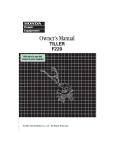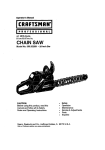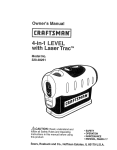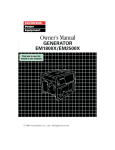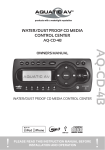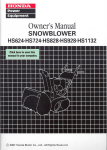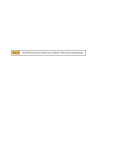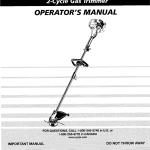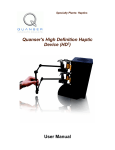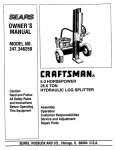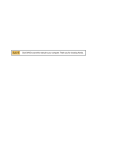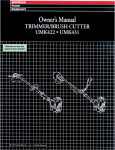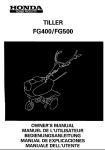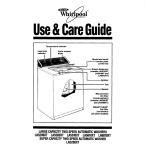Download Honda FG400 User's Manual
Transcript
The engine exhaust from this product contains chemicals known to the State of California to cause cancer, birth defects, or other reproductive harm. Keep this owner’s manual handy, so you can refer to it any time. This owner’s manual is considered a permanent part of the tiller and should remain with the tiller if resold. The information and specifications included in this publication were in effect at the time of approval for printing. Honda Motor Co., Ltd. reserves the right, however,to discontinue or change specifications or design atany time without notice and without incurring any obligation whatever. Congratulations on yourselection of a Honda tiller. We are certain you will be pleased with your purchase of one of the finest tillers on the market. We want to help you get the best results from your newtiller and to operate it safely. This manual contains all the information on how to do that; please read it carefully. 1-1 As you read this manual, you will find information preceded by a symbol. That information is intended to help you avoid damage to your tiller, other property, or the environment. We suggest you read the warranty policyto fully understand its coverage and your responsibilities of ownership. The warranty policy is aseparatedocument that should have been given to you by your dealer. When yourtiller needs scheduled maintenance, keep in mind that your Honda servicing dealer is specially trained in servicing Honda tillers and is supported by the parts and service divisions of American Honda. YourHonda servicing dealer is dedicated to your satisfaction and will be pleased to answer your questions and concerns. Best Wishes, Honda Motor Co., Ltd. 1 INTRODUCTION A FEW WORDS ABOUT SAFETY Your safety and the safety of others are very important. And using this tiller safely is an important responsibility. To help you make informed decisions about safety, we have provided operating procedures and other information on labels and in this manual. This information alerts you to potential hazards that could hurt you or others. Of course, it is not practical or possible to warn you about all the hazards associated with operating or maintaining a tiller. You must use your own good judgment. You will find important safety information in a variety of forms, including: Safety Labels - on the tiller. Safety Messages-preceded by a safety alert symbol A and one of three signal words: DANGER, WARNING, or CAUTION. These signal words mean: You WILL be KILLED or SERIOUSLY HURT if you don’t follow instructions. You CAN be KILLED or SERIOUSLY HURT if you don’t follow instructions. YouCANbeHURT follow instructions. if youdon’t Safety Headings - such as IMPORTANT SAFETY INFORMATION. Safety Chapter - such as TILLER SAFETY. 0 Instructions- how to use this tiller correctly and safely. This entire book is filled with important safety information - please read it carefully. 2 TILLER SAFETY ........................................................................................ IMPORTANT SAFETY INFORMATION ................................................. SAFETY LABEL LOCATIONS ............................................................... 5 5 CONTROLS ................................................................................................ COMPONENT & CONTROL LOCATIONS ............................................ CONTROLS ......................................................................................... Choke Rod ...................................................................................... Engine Switch .................................................................................. Recoil Starter ................................................................................... Throttle Lever .................................................................................. Handlebar Height Adjuster .............................................................. Main Clutch Lever ........................................................................... Drag Bar .......................................................................................... Front Wheel..................................................................................... Gearshift Lever ................................................................................ 9 9 10 10 10 10 11 11 11 12 12 12 BEFORE OPERATION............................................................................. ARE YOU READY TO GET STARTED? ............................................. IS YOUR TILLER READY TO GO? ..................................................... Check the Engine ............................................................................ Check the Tiller ............................................................................... 13 13 13 14 14 OPERATION ............................................................................................. SAFE OPERATING PRECAUTIONS................................................... STARTING THE ENGINE .................................................................... OPERATING THE CONTROLS FOR TILLING .................................... STOPPING THE ENGINE .................................................................... 15 15 16 19 23 SERVICING YOUR HONDA TILLER ....................................................... THE IMPORTANCE OF MAINTENANCE ............................................ MAINTENANCE SAFETY .................................................................... MAINTENANCE SCHEDULE .............................................................. REFUELING ......................................................................................... FUEL RECOMMENDATIONS.............................................................. ENGINE OIL LEVELCHECK ............................................................... ENGINE OIL CHANGE ........................................................................ ENGINE OIL RECOMMENDATIONS .................................................. TRANSMISSION OIL LEVELCHECK ................................................. AIR FILTER INSPECTION ................................................................... AIR FILTER CLEANING ...................................................................... SPARK PLUG SERVICE ..................................................................... 24 8 24 25 26 27 27 29 30 31 32 33 34 35 3 CONTENTS SERVICING YOUR HONDA TILLER (continued) CLUTCH CABLEADJUSTMENT ......................................................... THROTTLE CABLE ADJUSTMENT .................................................... DRIVE BELT ADJUSTMENT ............................................................... SPARK ARRESTER SERVICE ............................................................ 37 37 38 39 STORAGE ................................................................................................ STORAGE PREPARATION ................................................................. Cleaning .......................................................................................... Fuel ................................................................................................. Engine Oil ........................................................................................ STORAGE PRECAUTIONS ................................................................. REMOVAL FROM STORAGE ............................................................. 41 41 41 43 45 46 46 TRANSPORTING ..................................................................................... 47 TAKING CARE OF UNEXPECTED PROBLEMS.................................... ENGINE PROBLEMS .......................................................................... Engine Will Not Start ....................................................................... Engine Lacks Power ........................................................................ TILLING PROBLEMS ........................................................................... Poor Tilling Quality .......................................................................... 48 48 48 49 50 50 TECHNICAL & CONSUMER INFORMATION......................................... TECHNICAL INFORMATION ............................................................... Serial Number Locations ................................................................. Carburetor Modification for High AltitudeOperation ........................ Oxygenated Fuels ........................................................................... Emission Control System Information ............................................. Air Index .......................................................................................... Specifications .................................................................................. CONSUMER INFORMATION .............................................................. Honda Publications ......................................................................... Customer ServiceInformation ......................................................... 51 51 51 52 53 54 56 57 58 58 59 .......................... QUICK REFERENCE INFORMATION 4 Inside back cover TILLER SAFETY IMPORTANT SAFETY INFORMATION Honda tillers are designed to cultivate earth outdoors. Other uses can result in injury to the operator or damage to the tiller and other property. Most accidents can be prevented if you follow all instructions in this manual and on the tiller. The most common hazards are discussed below, along with the best way to protect yourself and others. Operator Responsibility Know how to stop the tiller quickly in case of emergency. Understand the use of all tiller controls. Bevery cautious when operatingthe tiller in REVERSE (A2 type), especially if attachments are being used. Keep a firm hold on the handlebars. They may tend to lift during clutch engagement. Be sure the drag bar is in place and properly adjusted. Be sure that anyone who operates the tiller receives proper instruction. Do not let children operate the tiller. Keep children and pets away from the area of operation. Carbon Monoxide Hazard Exhaust contains poisonous carbon monoxide, a colorless, odorless gas. Breathing exhaust can cause loss of consciousness and may lead to death. If you run the tiller in a confined or even partially enclosed area, the air you breathe could contain dangerous amounts of exhaust gas. To keep exhaust gas from building up, provide adequate ventilation. 5 TILLER SAFETY Fire and Burn Hazards The exhaust system gets hot enough to ignite some materials. - Keep the tiller at least 3 feet (1 meter) away from buildings and other equipment during operation. - Keep flammable materials away from the tiller. The muffler becomes veryhot during operation and remains hot for a while after stopping the engine. Be careful not to touch the muffler whileit is hot. Let the engine cool before storing the tiller indoors. Refuel With Care Gasoline is extremely flammable, and gasoline vapor can explode. Allow the engine to cool if the tiller has beenin operation. Refuel only outdoors in a wellventilated area with the engine OFF. Do not overfill the fuel tank. Never smoke near gasoline,and keepother flames and sparks away. Alwaysstore gasoline in an approvedcontainer. Make sure that any spilled fuel has been wiped up before starting the engine. Avoid Rotating Tines Rotating tines can cause seriouscuts and even amputatebody parts. Keep away from the tine area whenever the engine is running. If you need to work around the tines to clear a objectaccumulationor for any other reason, always shut off the engine. Disconnect the spark plug cap, and wear heavy gloves when you needto clean the tine area or handle the tines. Clear Tilling Area A tine can throw rocks and other objects with enough force to cause serious injury. Before tilling, carefully inspect the area and removeall stones, sticks, bones, nails, pieces of wire, and other loose objects. Be aware if children are in the area; stop the tiller. Never operatethe tines over gravel. TILLER SAFETY Keep Shieldsin Place Guards and shields are designed to protect you from being hit by thrown objects and to keep you from touching hot engine parts and moving compo For your safety and the safety of others, keep all shields in place when the engine is running. Wear Protective Clothing Wearing protective clothing will reduce your risk of injury. Long pants and eye protection reduce the risk of injuries from thrown objects. Sturdy shoes with aggressive soles provide better traction. Turn Engine Off When Not Operating the Tiller If you need to leave the tiller for any reason, even just to inspect the area ahead, always turn the engine off. Slope Operation When tilling on slopes, keep the fuel tank less than half full to minimize fuel spillage. Till across the slope (at equally spaced intervals) rather than up and down it. Be very careful when changing the direction of the tiller on a slope. Do not use the tiller on a slope of more than 10". Before starting the engine, check that the tiller is not damaged and is in good condition. For yoursafety and safety of others, exercise extreme care when using the tiller on a slope. Tilling Conditions Operate tiller only in daylight or good artificial light. Do not operate the tiller at night or under poor light conditions. 7 TILLER SAFETY SAFETY LABEL LOCATONS These labels warn you of potential hazardsthat can cause serious injury. Read them carefully. If a label comes off or becomes hard to read, contact your Honda servicing dealer for a replacement. 8 lFT CONTROLS COMPONENT & CONTROL LOCATIONS THROTTLE LEVER AIR CLEANER COVER SERIALENGINE V-BELT COVER FRONT WHEEL ROTOR CLUTCHLEVER PARK PLUG CAP HANDLEBAR HEIGHT ADJUSTER CHOKE ROD FRAME SERIAL NUMBE ECOIL STARTER TRANSMISSION OIL 9 CONTROLS CONTROLS Choke Rod The choke rod opens and closes the choke valvein the carburetor. The CLOSED position enriches the fuelmixture for startingacold engine. I The OPEN position provides the correct fuel mixture for operation after starting and for restarting a warm engine. Engine Switch Theengineswitchcontrolsthe ignition system. ON ENGINE SWITC OFF - Stops the engine. ON - Running position. Recoil 10 STARTER GRIP CONTROLS Throttle Lever The throttle lever controls engine speed. TLE Moving the throttle lever in the directions shown makes the engine run faster or slower. Tine speed iscontrolled by adjusting thethrottlelever. At maximum throttle position, the tines will rotate at the highest speed. Moving the throttle lever toward the idle position will decrease the tine speed. / FAST Handlebar Height Adjuster Handlebar height can be adjusted to match operator height. Fornormaltilling,themost comfortableoperator position is with the handlebars at waist height. Main Clutch Lever The main clutch lever engages and disengages the transmission that drives the tines. DISENGAGED CLUTCH LEVER 11 CONTROLS Gearshift Lever .EVER The transmission on the A2 type offers a choice of twoforward speeds and one reverse speed. Shift lever positions are indicated on the Change Lever Bracket. Drag Bar The drag bar controls tilling depth and should always be used when tilling. It enables you to compensate for the hardness of the soil. Ideal drag bar height will depend on the type of soil being tilled and soil conditions at the time of tilling. In general, the drag bar should be adjusted so that the tiller is tilted slightly backward. / PIN HITCH Front Wheel The front wheel is used to help move the tiller from one place to Lift another. handlebars to roll the tiller on the front wheel. Return the wheel to the raised position before tilling. Always stop the engine before lowering or raising the wheel. TILLING POSITION TRANSPORT POSITION ARE YOU READY TO GET STARTED? Your safety is your responsibility. A little time spent in preparation will significantly reduce your risk of injury. Knowledge Read and understand this manual. Know what the controls do and how to operate them. Familiarize yourself with the tiller and its operation before you begin using it. Know how to quickly shut off the tiller in case of an emergency. IS YOUR TILLER READY TO GO? For yoursafety, and to maximize the service life of your equipment, it is very important to take a few moments before you operate the tiller to check its condition. Be sure to take care of any problem you find, or have your servicing dealer correct it, before you operate the tiller. Improperly maintaining this tiller, or failing to correct a problem before operation, could cause a malfunction in which you could be seriously injured. Always perform a preoperation inspection before each operation, and correct any problem. 13 BEFORE OPERATION Do not place flammable objects close to the engine. Before beginning your preoperation checks, be sure the tiller is on a level surface andthe engine switch is in the OFF position. Check the Engine Check the oil level (see page29). Check the air filter (see page 33). A dirty air filter will restrict air flow to the carburetor, reducing engine and tiller performance. Check the fuel level (see page27). Starting with full a tank will help to eliminate or reduce operating interruptions for refueling. Check the Tiller Check the transmission oil (see page 32). 14 OPERATION SAFE OPERATING PRECAUTIONS Before operating the tiller for the first time, please review both the TlLLER SAFETY chapter and the chapter titled BEFORE OPERATION. For your safety,avoid starting or operating the tiller in an enclosed area such as a garage. Your tiller's exhaust contains poisonous carbon monoxide gas which can collect rapidly in an enclosed area and cause illness or death. Carbon monoxide gas is toxic. Breathing it can cause unconsciousness and even kill you. Avoid any enclosed areas or activities that expose you to carbon monoxide. 15 OPERATION STARTING THE ENGINE Refer to Safe Operating Precautionson Page 15. Tines are sharp and spin fast. Spinning tines can cut you severely and can amputate body parts. Wear protective footwear. Keep your hands and feet away from the tines while the engine is running. Stop the engine before performing any adjustment, inspection, or maintenance. 1. Pull thechoke rodto the CLOSED position to start a cold engine. / , - Leavethe choke rod in the OPEN positionto restart a warm engine. CHOKE ROD 16 OPERATION 2. Turn the engine switch to the ON position ON 3. Move the throttle lever away from the SLOW position, about 1/3 of thewaytowardthe FAST position. THROTTLE LEVER ow 4. Pull the starter grip lightly until STARTER GRIP you feel resistance, then pull briskly. Do not allow the starter grip to snap back against the engine. Returnitgentlytoprevent damage to the starter. 17 OPERATION 5. If the choke rod was pulled to the CLOSED position to start the engine, gradually move it to the OPEN position as the engine warms up. 18 CHOKE ROD /-t- OPERATION ~~ ~~~ OPERATING THE CONTROLS FOR TILLING If the tines dig in but the machinewill not move forward, move the handlebars from side-to-side. When turning, push down onthe handlebars to bring the tiller's weight to the rear; this will make turning easier. Handlebar Height Adjustment Stop theengine before adjusting the handlebar height. 111 I HE To adjust the handlebar height, loosenthehandlebarheight adjuster, select theappropriate holes andtighten it. Clutch DISENGAGED Whenthemain clutchleveris squeezed, the clutch is engaged, andpower is transmitted to the transmission. CLUTCH LEVER When the lever is released, the clutch is disengaged, and power is not transmitted. 19 OPERATION ~~ Forward Gear Selection(A2 type only) 1. Return the throttle lever to the slowest position. 2. Release the clutch lever to disengage the clutch. 3. Move the shift lever to the desired gear position. If the shift lever will not engage the desired gear, squeeze the clutch lever and move the tiller slightly to reposition the gears. HANGE LEVER RACKET I NEUTRAL 20 OPERATION Reverse Gear Operation(A2 Type) Use the reverse gear only when it is necessary to move the tiller away from an obstacle. The tiller tines propel the tiller toward the operator when operated in reverse. Contact with rotating tines will cause serious injury. Be prepared to quickly release the clutch lever when operating the tiller in reverse. 1. Check the area behind you and make sure it is clear of any obstacles. 2. Verify the transport wheel is raised. 3. Move the throttle to the SLOW position. 4. Raise the handlebar up so the transport wheel contacts the ground. This raises the drag bar out of the soil to allow easyrevers gear operation. 5. Make sure the clutch lever is released. Move the shift lever to the REVERSE position. 6. Engage the clutch lever and carefully walk the tiller backwards. Be prepared to release the clutch lever quickly. 7. Release the clutch lever, lower the handlebar, and move the shift lever out of the REVERSE position when done. 21 ~~~~~~ Tiling Depth Adjustment The drag bar is used to control the tilling depth, which can be adjusted by removing the pin and retainer and sliding the drag bar up and down as necessary. During operation, if the machine jerks forward while tilling, press down on the handlebars. This will cause the drag bar to dig more deeply into the soil. Front Wheel After getting to the tilling site, move the front wheel to the raised position before tiling. Always stop the engine before lowering or raising the wheel. To raise or lowerthe wheel, pull out the wheel assembly, move the wheel, then release the wheel assembly. TILLING POSITION TRANSPORT POSITION 22 OPERATION STOPPING THE ENGINE To stop the engine in an emergency, simply turn the engine switch to the OFF position. Under normal conditions, use the following procedure. 1. Release the main clutch lever to the DISENGAGED position, and move the shift lever to the neutral position (A2 type). 2. Move the throttle lever to the slowest position. 3. Turn the engine switch to the OFF position. OFF OFF /- ENGINE SWITCH 23 THE IMPORTANCE OF MAINTENANCE Good maintenance isessential for safe, economical, trouble-free and operation. It will also help reduce air pollution. To help you properly care foryour tiller, the following pages include a maintenanceschedule,routine inspection procedures, and simple maintenan procedures using basic hand tools. Other service tasks that are more difficult, or require special tools, are best handled by professionals and are normally performed by a Honda technician or other qualified mechanic. The maintenance schedule applies to normal operating conditions. If you operate your tiller under unusual conditions, (such as sustained high-load or high-temperature operation, or use in dusty conditions), consult your servicing dealer for recommendations applicable to your individual needs and use. Improper maintenance, or failure to correct a problembefore operation, cancause a malfunction in which you can be seriously hurt or killed. Always follow the inspection and maintenance recommendations and schedules in this owner’s manual. Remember that your servicing dealer knows your tiller best and is fully equipped to maintain and repair it. To ensure the best quality and reliability, use only new, genuine Honda parts or their equivalents for repair and replacement. Maintenance, replacement, or repair of the emission control devices and systemsmaybeperformedbyanyenginerepairestablishmentor individual, using parts that are “certified” EPA to standards. 24 SERVICING YOUR HONDA TILLER MAINTENANCE SAFETY Some of the most important safety precautions follow. However, we cannot warn youof every conceivablehazardthat can arise in performing maintenance. Only you can decide whether or not you should perform a given task. Failuretoproperlyfollowmaintenance instructions and precautions can cause you to be seriously hurt or killed. Always follow the procedures and precautions in the owner’s manual. Safety Precautions Make sure the engine is off before you begin any maintenance or repairs. This will eliminate several potential hazards: - Carbon monoxide poisoning from engine exhaust. Be sure there is adequate ventilation whenever you operate the engine. - Burns from hot parts. Let the engine and exhaust system cool before touching. - Injury from moving parts. Do not run the engine unless instructed to do so. Read the instructions before you begin, and make sure you have the tools and skills required. To reduce the possibility of fire or explosion, be careful when working around gasoline. Use only anonflammable solvent, not gasoline, to clean parts. Keep cigarettes, sparks, and flames away from all fuelrelated parts. Disconnect the spark plug cap and wearheavy gloves when working near the tine blades. SERVICING YOUR HONDA TILLER MAINTENANCE SCHEDULE Every Every Every 3 months 6 months year or or or 50 hrs. 100 hrs. 25 hrs. Every 2 years or 250 hrs. I o I Io 0 --t--tFirst tlme 25 hrs. (3) First time 25 hrs. (3) 0 I Fuel tank and filter I I 0 Valve clearance Combustion chamber Fuel tube Clean Check-Adjust Clean Check I L I 0 (3) 1Mer every 250 hrs. (3) ~. Every 2 years (Replace if necessary) (3) Emission related items. (1) Service more frequently when used in dusty areas. (2) Change engine oil every 25 hours when used under heavy load or in high ambient temperatures. (3) These items should be serviced by your servicing dealer, unless you have the proper tools and are mechanically proficient. Refer to Honda shop manual for service procedures. (4) Log hours of operation to determine proper maintenance intervals. 26 SERVICING YOUR HONDA TILLER REFUELING Fuel tank capacity: FG400 FG500 0.45 US gal (1.7i?, 0.37 Imp gal) 0.53 US gal (2.0i?,0.44 Imp gal) With the engine stopped, remove the fuel tank cap andcheck the fuel level. Refill the tank if the fuel level is low. Do not fill above the fuel level mark. Gasoline is highly flammable and explosive. You can be burned or seriously injured when handling fuel. Stop the engine and keep heat, sparks, and flame away. Refuel only outdoors. Wipe up spills immediately. Refuel in a well-ventilated area before starting the engine. If the engine has been running, allow it to cool. Refuel carefully to avoid spilling fuel. Do not fill the fuel tankabove the fuel level mark. After refueling, tighten the fuel tankcap securely. Never refuel the engine inside a building where gasoline fumes may reach flames or sparks. Keep gasoline away from appliance pilot lights, barbecues, electric appliances, power tools, etc. Spilled fuel is not only a fire hazard, it causes environmental damage. Wipe up spills immediately. FUEL RECOMMENDATIONS Use unleaded gasoline witha pump octane ratingof 86 or higher. This engine is certified to operate on unleaded gasoline. Unleaded gasoline produces fewer engine and spark plug deposits and extends exhaust system life. 27 SERVICING YOUR HONDA TILLER Never use stale or contaminated gasoline or an oil/gasoline mixture. Avoid getting dirt or water in the fuel tank. Occasionally you may hear light “sparkknock’ or “pinging” (metallic rapping noise) while operating under heavy loads. This is no cause for concern. If spark knockor pinging occurs at a steady engine speed, under normal load, changebrands of gasoline. If spark knock or pinging persists,seean authorized Hondaservicing dealer. I NOTICE I Running the engine with persistent spark knock or pinging can cause e damage. Running the enginewith persistent spark knock or pinging is misuse, and the Distributor’s Limited Warrantydoes not cover parts damaged by misuse. 28 SERVICING YOUR HONDATILLER ENGINE OIL LEVEL CHECK Check the engine oil level with the tiller on a level surface and the engine stopped. 1. Remove the oil filler cap/dipstick and wipe it clean. 2. Insert and remove the dipstick without screwing it into the filler neck. Check the oil level shown on the dipstick. 3. If the oil level is low, fill to the top of the oil filler neck with the recommended oil (see page31). 4. Screw in the filler cap/dipstick securely. OIL FILLER CAPlDlPSTlCK NECK tl+ LOWER LlMT 29 SERVICING YOUR HONDA TILLER ENGINE OIL CHANGE Drain the oil while the engine is warm to assure rapid and completedraining. 1. Place a suitable container below the engine to catch the used oil, then remove the filler cap/dipstick, drain plug and sealing washer. 2. Allow the used oil to drain completely, then reinstall the drain plug and sealing washer. Tighten the plug securely. lxEia Improper disposal of engine oil can be harmful to the environment. If you change your own oil, please disposeof the used oil properly. Put it ina sealed container and take it atorecycling center.Do not discard ita trash in bin or dumpit on the ground. 3. With the tiller in a level position, fill to the outer edge of the oil filler hole with the recommended oil (see page29). Oil Capacity: 0.61 US qt (0.58 4) 1Running the engine witha low oil level can cause engine damage. 4. Screw in the filler cap securely. OIL FILLER CAP/DIPSTICK NECK 11 UPPER LlMT - DRAIN r - y LOWER LlMT 30 SERVICING YOUR HONDA TILLER ENGINE OIL RECOMMENDATIONS Oil is a major factor affecting performance and service life. Use a 4-stroke automotive detergent oil. ’ SAE 1OW-30 is recommended for general use. Otherviscosities shown in the chart may be used when the average temperature in your area is within the recommended range. SAE VISCOSITY GRADES -20 0 40 20 60 80 I -30 100 ‘F I -20 -10 0 10 20 30 40 ‘C AMBIENTTEMPERATURE The SAE oil viscosit! and service classification are in the API label on the oil container. Honda recommends that you use API SERVICE category SJ oil. 31 SERVICING YOUR HONDA TILLER TRANSMISSION OIL LEVEL CHECK Check the transmission oil level with the tiller on a level surface and the engine stopped. 1. Remove the transmission oil filler cap. The oil should be level with the lower 1 edge of the oil filler hole. 2. Add the same oil as recommended for the engine (see page 31), if the level is low. < 3. Screw in the filler cap securely. , $ .-- OIL FILLER HOLE LOWER EDGE OF THE OIL FILLER HOLE 32 TRANSMISSION OIL FILLER CAP I SERVICING YOUR HONDA TILLER AIR FILTER INSPECTION ' Press the latch tabs on the fueltank side of the air cleaner cover, remove the air cleaner cover, and remove the filter. Check the filterto be sureit is clean and in good condition. If the filter is dirty, remove the filter and cleanit as described on page34. Replace the filterif it is damaged. Reinstall the filterand air cleaner cover. Make sure thelatch tabs aresecured. Operating the engine without an airor with filter, a damaged air filter, will all dirt to enter the engine, causing rapid engine wear. of This type is not damage covered by the Distributor's Limited Warranty. e AIR CLEANER COVER LATCH TABS / TABS AIR FILTER 33 SERVICING YOUR HONDATILLER AIR FILTER CLEANING A dirty air filter will restrict air flow to the carburetor, reducing engine performance. If you operate the engine in very dusty areas, clean the air filter more frequently than specified in the Maintenance Schedule. 1. Tap the air filter element several times on a hard surface to remove dirt, or blow compressed air [not exceeding 30 psi (207 kPa, 2.1 kgf/cm2)]through the air filter from the air cleaner housing side. Never try to brush off dirt; brushing will force dirt into the fibers. Replace the air filter if it is excessively dirty. 2. Wipe dirt from the air cleaner housing and cover using a moist rag. Be careful to prevent dirt from entering the air duct that leads to the carburetor. 34 I , SERVICING YOUR HONDA TILLER SPARK PLUG SERVICE Recommended spark plug: BPR6ES (NGK) Incorrect spark plugs can cause engine damage. 1. Disconnect the spark plug cap, and remove any dirt from around the spark plug area. 2. Remove the spark plug with a 13/16-inch spark plug wrench. PULG WRENCH I ' \ - 1 I f 3. Inspect the spark plug. Replace it if the electrodes areworn,or if theinsulator is cracked or chipped. / (0.70 - 0.80 mm) 4. Measure thespark plug electrode gap with a suitable gauge. The gap should be 0.028 - 0.031 in (0.70 - 0.80 mm). Correct the gap,if necessary, by carefully bending the side electrode. 5. Installthesparkplug carefully, by hand, to avoid cross-threading. 6. After the sparkplug seats, tighten with a 13/16 - inch spark plug wrench to compress the washer. 35 SERVICING YOUR HONDA TILLER If reinstalling a used sparkplug, tighten 1/8 - 1/4 turn after the spark plug seats. If installing a new spark plug, tighten 1/2 turn after the spark plug seats. A loose spark plug can overheat and damage the engine. Overtightening the sparkplug can damage the threads in the cylinder he 7 Attach the spark plug cap. 36 SERVICING YOUR HONDA TILLER CLUTCH CABLE ADJUSTMENT There should be 3/16 - 3/8 inches (5- 10 rnm) of free play at the lever end. If lever adjustment is incorrect, loosen the lock nut and turn the adjusting bolt in or out just enough to eliminate free play. Do not overtighten. LOCK NUT ADJUSTING NUT THROlTLE CABLE ADJUSTMENT Measure the free play at the lever tip. Free play : 1-3/16 - 1-9/16 in (30 - 40 rnm) If the free play is incorrect, turn the adjusting nut in or out as required. 1-3/16- 1-9/16in (30- 40 mm) 37 SERVICING YOUR HONDA TILLER DRIVE BELT ADJUSTMENT 1. Adjust the clutch cable (page 37). Belt tensioniscorrectwhenthe the form distance beltof the to thetop of the tension roller is 1-3/4 -in 1-15/16 mm) (45 - 49 when the clutch is engaged. 2. TO adjust, loosen the four engine mountingboltsand the three inner belt cover tightening bolts and move the engine forward or backward to get proper tension on the belt. After adjusting the tension, usea straight edge to make sure that the outside face of the drive pulley is flush with the outside face of thedriven pulley. in r INNER BELT COVERTIGHTENINGBOLTS MOUNTING BOLTS 3. Loosen the belt stopper attaching bolts. Adjustthe clearance between the belt stopper and the belt as illustrated with the clutch lever squeezed. 1132 - 118 in I1 - 3 mm) + 1132 - 118 in (1 318 - 112 in (10- 13 mm) 38 - 3 mm) SERVICING YOUR HONDA TILLER SPARK ARRESTER SERVICE Your engine is not factory-equipped with a spark arrester. In some areas, it is illegal to operate an engine without a spark arrester. Check local laws and regulations. A spark arrester is available from Honda servicing dealers. The spark arrester must be serviced every 100 hours to keep it functioning as designed. If the engine has been running, the muffler will be very hot. Allow the muffler to cool before servicing the spark arrester. 1. Remove the three 6 mm bolts from the muffler protector, and remove the muffler protector. 2. Remove the two special screws from the spark arrester, and remove the spark arrester from the muffler. MUFFLER PROTECTOR BOLTS 39 SERVICING YOUR HONDA TILLER 3. Use abrush to removecarbon deposits from the spark arrester screen. Be careful to avoid damagingthe screen. The spark arrester must be free of breaks and holes. Replace the spark arrester if it is damaged. SPARK ARRESTER SCREEN 4. Install the spark arrester and muffler protector, in the reverse order of disassembly. 40 STORAGE PREPARATION Proper storage preparation is essential for keeping your tiller trouble free and looking good. The following steps will help to keep rust and corrosion from. impairing your tiller’s function and appearance, and will make the engine easier to start when you use tiller again. Cleaning 1. Wash the tiller, including the underside. Engine Wash the engine by hand, and becareful to prevent water from entering the air cleaner. 1 NOTICE 1 Using a garden hose or pressure washing equipment can force water into the air cleaner. Water in the air cleaner will soak the filter elements and can enter the carburetor or engine cylinder, causing damage. Water contacting a hot engine can cause damage. If the engine has been running, allow it to cool at forleast half an hour before washing. Tiller If using a garden hose or pressure washing equipment to clean the tiller, be careful to avoid getting water on the belts. Spraying wateron hot tine shaft bearings can cause them to be dama from cooling too quickly. 41 STORAGE 2. After washing the tiller, wipe dry all accessible surfaces. 3. Start the engine outdoors, and let it run until it reaches normal operating temperature to evaporate any water remaining on the engine. 4. While the engine is running, operate the clutch lever to expel water from the pulleys, belts, and other moving items. 5. Stop the engine and allow it to cool. 6. After the tiller is clean and dry, touch up any damaged paint and coat other areas with a light film of oil. Lubricate the throttle cable core with a silicone spray lubricant. 42 STORAGE Fuel Gasoline will oxidize and deteriorate in storage. Old gasoline will cause hard starting, and it leaves gum deposits that clog the fuel system. If the gasoline in your tiller deteriorates during storage, you may need to have the carburetor and other fuel system components serviced or replaced. The length of time that gasoline can be left in your fuel tank and carburetor without causing functional problems will vary with such factors as gasoline blend, your storage temperatures, and whether the fuel tank is partially or completely filled. The air in a partially filled fuel tank promotes fuel deterioration. Verywarm storage temperatures accelerate fuel deterioration. Fuel deterioration problems may occur within a few months, or even less if the gasoline was not fresh when you filled the fuel tank. The Distributor’s Limited Warranty does not cover fuel system damage or engine performance problems resulting from neglected storage preparation. You can extend fuel storage life by adding a gasoline stabilizer that is formulated for that purpose, or you can avoid fuel deterioration problems by draining the fuel tank and carburetor. Adding a Gasoline Stabilizer to Extend Fuel Storage Life When adding a gasoline stabilizer, fill the fuel tank with fresh gasoline. If only partially filled, air in the tank will promote fuel deterioration during storage. If you keepacontainerofgasolineforrefueling, besurethatitcontainsonlyfresh gasoline. 1. Add gasoline stabilizer following manufacturer’s instructions. 2. After adding a gasoline stabilizer, run the engine outdoors for 10 minutes to be sure that treated gasoline has replaced the untreated gasoline in the carburetor. 3. Stop the engine. 43 STORAGE Draining theFuel Tank and Carburetor 1. Remove the fuel filler cap, and empty the fuel tank into an approved gasoline container using a commercially available hand siphon. Reinstall the fuel filler cap. 2. Place an approved gasoline container below the carburetor, and use a funnel to avoid spilling fuel. 3. Loosen the carburetor drain screw to drain the carburetor. Gasoline is highly flammable and explosive. You can be burned or seriously injured. Never use gasoline to clean engine parts. Use a nonflammable solvent. CARBURETOR 4. After all the fuel has drained into the container, tighten the drain screw securely. 44 ' STORAGE Engine Oil 1. Change the engine oil (page 30). 2. Remove the spark plug (page 35). ' 3. Pour a tablespoon (5 - 10 cc) of clean engine oil into the cylinder. 4. Pull the starter rope several times to distribute the oil in the cylinder. 5. Reinstall the spark plug. 6. Pull the starter rope slowly until resistance is felt. This will close the valves, so moisture cannot enter the engine cylinder. Return the starter rope gently. 45 STORAGE STORAGE PRECAUTIONS If your tiller will be stored with gasoline in the fuel tank and carburetor, it is important to reduce the hazard of gasoline vapor ignition. Select a well ventilated storage area away from any appliance that operates with a flame, such as a furnace, water heater, or clothes dryer. Also avoid any area with a spark-producing electric motor, or where power tools are operated. If possible, avoid storage areas with high humidity, because that promotes rust and corrosion. Unless all fuel has been drained from the fuel tank, leave the fuel valve in the OFF position to reduce the possibility of fuel leakage. Place the tiller on a level surface. Tilting can cause fuel or oil leakage. With the engine and exhaust system cool, cover the tiller to keep out dust. A hot engine and exhaust system can ignite or melt some materials. Do not use sheet plastic as a dust cover. A nonporous cover will trap moisture around the tiller, promoting rust and corrosion. REMOVAL FROM STORAGE Check your tiller as described in the BEFORE OPERATlONchapter of this manual. If the fuel was drained during storage preparation, fill the tank with fresh gasoline. If you keep a container of gasoline for refueling, be sure that it contains only fresh gasoline. Gasoline oxidizes and deteriorates over time, causing hard starting. If the cylinder was coated with oil during storage preparation, the engine may smoke briefly at start-up. This is normal. 46 . BEFORE LOADING If the engine has been running, allow it to cool for at least 15 minutes before loading the tiller on the transport vehicle. A hot engine and exhaust system can burn you and can ignite some materials. * Always turn the ignition switch to the OFF position. LOADING AND UNLOADING If asuitable loading ramp is not available, two people should lift the tiller on and off the transport vehicle while holding the tiller level. Position the tiller so it sits flat on the bed of the transport vehicle. Tie the tiller down with rope or straps. Keep the tie-down rope or straps away from the controls, adjustment levers, cables, and the carburetor. 47 ENGINE PROBLEMS Engine Will Not 1. Check control Possible Cause Correction Choke OPEN. Move to CLOSED unless engine is warm. Engine switch OFF Turn engine switch to ON. Out of fuel. Refuel (p.27). Bad fuel; tiller stored without treating or draining gasoline, or refueled with bad gasoline. Drain fuel tank and carburetor (p.44). Refuel with fresh gasoline (P.27). 3. Checkengineoil level. Low oil level caused Oil Alert to stoD enaine. Add oil (p.29). 4. Remove and inspect spark plug. Spark plug faulty, fouled, or improperly gapped. Clean, gap, or replace spark plug (p.35). Spark plug wet with fuel (flooded engine). Dry andreinstall spark plug. Start engine with throttle lever in FAST position. positions. 2. Check fuel. I I 5. Take tiller to an authorized Honda servicing dealer, or refer to the Fuel filter clogged, carbu- Replace or repair faulty retor malfunction, ignition componentsasnecesmalfunction,valvesstuck, sary. etc. TAKING CARE OF UNEXPECTED PROBLEMS II Engine Lacks Power 1. Check air filter. 2. Check fuel. rized Honda servicing dealer, or refer to the shop manual. Possible Cause Correction Clean or replace air filter (P.34). Drain fuel tankand carbuBadfuel;tillerstored without treating or drain- retor (p.44). ing gasoline, or refueled Refuelwith fresh gasoline with bad gasoline. (P.27). Air filter clogged. Fuel filter clogged, carburetor malfunction, ignition malfunction, valves stuck, etc. Replace or repair faulty components as necessary. 49 TAKING CARE OF UNEXPECTED PROBLEMS TILLING PROBLEMS I PoorTillingQuality I Possible Cause 1. Check that the throttle Engine speed is too slow lever isin the FAST to till well. position. I Correction Move the throttle to the FAST position (p.11). 2. Reduce forward speed. Tiller is movingtoo fast for soil conditions. to slower speed 3. Check drag bar depth setting. Drag bar adjustment set to high. Lower drag bar adjustment (p.22). 4. Check tines. Tines dull, worn, or aged. dam- tines if neces- I Install correct tines. Tines installed incorrectly. I Install tines correctly. Wrong tines installed. 50 TECHNICAL & CONSUMER INFORMATION TECHNICAL INFORMATION Serial Number Loc FRAME Record the engine and frame serial numbers in the spaces below. You will need this serial number when ordering parts, and when making technical or warranty inquires. (see page 59.) Engine serial number: Frame serial number: 51 TECHNICAL & CONSUMER INFORMATION Carburetor Modification for High Altitude operation At high altitude, the standard carburetor air-fuel mixture will be too rich. Performance will decrease, and fuel consumption will increase. A very rich mixture will also foul the spark plug and cause hard starting. Operation at an altitude that differs from that at which this engine was certified, for extended periods of time, may increase emissions. High altitude performance can beimproved by a specific modifications to the carburetor. If you always operate your tiller at altitudes above 5,000feet (1,500 meters) have your servicing dealer perform this carburetor modification. This engine, when operated at high altitude with the carburetor modifications for high altitude use, will meet each emission standard throughout its useful life. Even with carburetor modification, engine horsepower will decrease about 3.5%for each 1,000-foot (300-meter) increase in altitude. The effect of altitude on horsepower will be greater than this if no carburetor modification is made. When the carburetor has been modified for high altitude operation, air-fuel the mixture willbe too lean for low altitude use. Operation at altitudes below5,000 feet (1,500 meters) with a modified carburetor may cause the engine to overheat and result in serious engine damage.use Forat low altitudes, have your servicing dealer return the carburetor to original factory specification. TECHNICAL & CONSUMER INFORMATION Oxygenated Fuels Some conventional gasolines are being blended with alcohol or an ether compound. These gasolines are collectively referred to as oxygenated fuels. To meet clean air standards, some areas of the United States and Canada use oxygenated fuels to help reduce emissions. If you use an oxygenated fuel, besure it is unleaded and meets the minimum octane rating requirement. Before using an oxygenated fuel, try to confirm the fuel’s contents. Some states/provinces require this information to be posted on the pump. The following are the EPA approved percentages of oxygenates: ETHANOL -(ethyl or grain alcohol) 10% by volume You may use gasoline containing up to 10% ethanol by volume. Gasoline containing ethanol may be marketed under the name “Gasohol”. MTBE (Methyl Tertiary Butyl Ether) 15% by volume Youmay use gasoline containing up to 15% MTBE by volume. METHANOL -(methyl or wood alcohol) 5% by volume You may use gasoline containing up to 5% methanol by volume, as long as it also containscosolvents and corrosion inhibitors to protect the fuel system. Gasoline containing more than 5% methanol by volume may cause starting and/ or performance problems. It may also damage metal, rubber, and plastic parts of your fuel system. If you notice any undesirable operating symptoms, try another service station, or switch to another brand of gasoline. Fuel system damage or performance problems resulting from the use of an oxygenated fuel containing more than the percentages of oxygenates mentioned above are not covered under warranty. 53 TECHNICAL & CONSUMER INFORMATION Emission Control System Information Source of Emissions The combustion process produces carbon monoxide, oxides of nitrogen, and hydrocarbons. Control of hydrocarbons and oxides of nitrogen is very important because, under certain conditions, they react to form photochemical smog when subjected to sunlight. Carbon monoxide does not react in the same way, but it is toxic. - Honda uses lean carburetor settings and other systems to reduce the emissions of carbon monoxide, oxides of nitrogen, and hydrocarbons. The U.S. and California Clean Air Act EPA and California regulations require all manufacturers to furnish written instruction describing the operation and maintenance of emission control systems. The following instructions and procedures must be followed in order to keep the Honda engine emissions within the emission standards. Tampering and Altering Tampering with or altering the emission control system may increase emissions beyond the legal limit. Among those acts that constitute tampering are: Removal or alteration of any part of intake, fuel, or exhaust system. Altering or defeating the governor linkage or speed-adjusting mechanism to cause the engine to operate outside its design parameters. 54 * TECHNICAL & CONSUMER INFORMATION Problems That May Affect Emissions If you are aware of any of the following symptoms, have your engine inspected and repaired by your authorized Honda servicing dealer. Hard starting or stalling after starting. Rough idle. Misfiring or backfiring under load. 0 Afterburning (backfiring). Black exhaust smoke or high fuel consumption. Replacement Parts The emission control systems on your new Honda engine were designed, built, and certified to conform with EPA and California emission regulations. We recommend the use genuine Honda parts whenever you have maintenance done. These original-design replacement parts are manufactured to the same standards as the original parts, so you can be confident of their performance. The use of replacement parts that are not of the original design and quality may impair the effectiveness of your emission control system. A manufacturer of an aftermarket part assumes the responsibility that the part will not adversely affect emission performance. The manufacturer or rebuilder of the part must certify that use of the part will not result in afailureof the engine to comply with emission regulations. Maintenance Follow the Maintenance Schedule on page 26. Remember that this schedule is based on the assumption that your machine will be used for its designed purpose. Sustained high-load or high-temperatureoperation, or use in unusually wet or dusty conditions, will require more frequent service. 55 TECHNICAL & CONSUMER INFORMATION Air Index An Air Index Information hang tag/label is applied to engines certified to an emission durability time period in accordance with the requirements of the California Air Resources Board. The bar graph is intended to provide you, our customer, the ability to compare the emissions performance of available engines. The lower the Air Index, the less pollution. The durability description is intended to provide you with information relating to the engine’s emission durability period. The descriptive term indicates the useful-life period for the engine’s emission control system. See your Emission Control Warrantyfor additional information. Descriptive Term Moderate Intermediate Extended Applicable to Emissions Durability Period 50 hours (0 - 65 cc) 125 hours (greater than65 cc) 125 hours (0 - 65 cc) 250 hours (greater than 65 cc) 300 hours (0 - 65 cc) 500 hours (greater than65 cc) The Air Index Information hang tag must remain on the tiller until it is sold. Remove the hang tag before operating the tiller. TECHNICAL & CONSUMER INFORMATION Specifications Model I Power equipment description code FG500-A1 1 FG500-A2 FG400-A1 FZCW FZCY 99 Ibs (45 kg) 106 Ibs (48 kg) 108 Ibs (49 kg) ~ Dry weight 53.1 in (1,350 mm) Length Width 25.8 in (655 mm) Height in (1,070mm) I Engine Model I 42.9 in (1,090mm) 42.1 I GC135 GC160 Single cylinder, 4-stroke, forced air cooled, over head valve, gasoline 8.2 cu-in (135 cm3) Displacement Bore x Stroke (64x42 mm) Ignition System 2.5 X 2.0 in (64 X 50 mm) 2.5X1.7 in Transistorized magneto Spark Plug I 9.8 cu-in (160 cm3) BPR6ES (NGK) Oil Capacity Fuel Tank Capacity I 0.61 US qt (0.58 4) 0.45 US gal (1.7 E) I 0.53US gal (2.0 E) I Clutch Belt tension type 1.O US qt (0.95 e , 0.84 Imp qt) Transmission Oil Capacity Tune-up Specifications I ITEM MAINTENANCE Spark Plug Gap 0.028 - 0.031 in (0.70 0.80 mm) Refer to page: 35 Valve Clearance IN: 0.1 1 0.19 mm cold EX: 0.1 6 0.24 mm cold Seeyourauthorized Honda dealer I Other Specification I -- other No adjustments needed. SPECI I NOTE: Specifications are subject to change without notice. 57 TECHNICAL & CONSUMER INFORMATION CONSUMER INFORMATION Honda Publications These publications will give you additional information for maintaining and repairing your tiller. You may order them from your Honda tiller dealer. Shop Manual This manual covers complete maintenance and overhaul procedures. It is intended to be used by a skilled technician. Parts Catalog This manual provides complete, illustrated parts lists. 58 TECHNICAL & CONSUMER INFORMATION ~ Customer Service Information * * Honda Power Equipment dealership personnel are trained professionals. They should be ableto answer any question you may have.If you encounter a problem that your dealerdoes not solve to your satisfaction, please discuss it with the dealership’s management. TheService Manageror General Manager can help.Almost all problems are solved in this way. If you are dissatisfied with the decision made by dealership’s management, contact the Honda PowerEquipmentCustomerRelations Office. You can write: American Honda Motor Co., Inc. Power Equipment Division Customer Relations Office 4900 Marconi Drive Alpharetta, Georgia 30005 - 8847 Or telephone: (770) 497 - 6400 When youwrite or call, please give us this information: Model and serial numbers (see page 51) Name of the dealer who sold the tiller to you Name and addressof the dealer who services your tiller Date of purchase Your name, address, and telephone number 0 A detailed description of the problem 59 60 Unleaded gasoline with a pump octane rating of 86 or higher (page 27) Fuel Capacity Engine Oil Spark Plug Carburetor FG400 : 0.45 US gal (1.71) FG500 : 0.53 US gal (2.01) Capacity SAE 10 W - 30, API SJ, for general use (page 31) 0.51 US qt (0.581) Type BPR6ES (NGK) Gap Idle speed 0.028 TY Pe - 0.031 in (0.7 - 0.8 mm) 1,400 f 150 rpm Beforeeach use Check engine oil level. Check air filter. Tiller outside Each lever function Bolt and nut torque Cables and wires Engine operation Transmission oil First 5 hours Change engine oil Subsequent Refer to maintenance schedule (page 26) Maintenance
































































